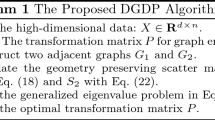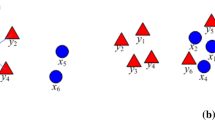Abstract
Graph embedding-based discriminative dimensionality reduction has attracted much more attention over the past few decades. In constructing adjacent graphs in graph embedding, the weight functions are crucial. The weight function is always found experimentally in practice. So far, there is no any theorem to guide the selection of weight functions. In this study, from the view point of hypothesis-margin, a theoretical framework has been presented to answer the problem above, which can guarantee the fact that the selected weight functions based on the proposed theorem can achieve large hypothesis-margin between near neighbors, improving the classification performance. Then, based on the proposed framework, we design a series of more discriminant weight functions. Sequentially, by constructing double adjacency graphs, we propose a more effective weighted double adjacency graphs-based discriminant neighborhood embedding (WDAG-DNE). Experimental results illustrate that the proposed theorem and WDAG-DNE are more effective.







Similar content being viewed by others
Explore related subjects
Discover the latest articles, news and stories from top researchers in related subjects.References
Shen XJ, Liu SX, Bao BK (2020) A generalized least-squares approach regularized with graph embedding for dimensionality reduction. Pattern Recognit 98:107023
He XF, Yan SC, Hu YX, Niyogi P, Zhang HJ (2005) Face recognition using Laplacianfaces. Pattern Anal Mach Intell 27:328–340
Turk M, Pentland A (1991) Eigenfaces for recognition. J Neurosci 3(1):71–86
P.N. Belhumeur, J.P. Hespanha, D. Kriegman, Eigenfaces vs. Fisherfaces: Recognition using class specific linear projection. IEEE Trans. Pattern Anal. Mach.Intell. 19 (7) (1997) 711–720.
Belkin M, Niyogi P (2003) Laplacian eigenmaps for dimensionality reduction and data representation. Neural Comput 15:1373–1396
X. He, S. Yan, Y. Hu, et al. Face recognition using laplacianfaces. IEEE Transactions on Pattern Analysis & Machine Intelligence (2005) 328–340.
Cai H, Zheng V, Chang K (2017) A comprehensive survey of graph embedding: problems, techniques and applications. IEEE T Knowl DATA En 30(9):1616–1637
Goyal P, Ferrara E (2018) Graph embedding techniques, applications, and performance: a survey. Knowl-Based Syst 151:78–94
Roweis ST, Saul LK (2000) Nonlinear dimensionality reduction by locally linear embedding. Science 290:2323–2326
M. Balasubramanian, E. Schwartz, J. Tenenbaum, V.d. Silva, J. C. Langford.The isomap algorithm and topological stability. Science 295 (2002)7a-7.
H.C. Qu, L. Li, Z.N. Li, et al. Supervised discriminant isomap with maximum margin graph regularization for dimensionality reduction. Expert Syst. Appl. 180(15)(2021)115055.
He X, Yan S, Hu Y et al (2005) Face recognition using Laplacian faces. IEEE T Pattern Anal 27(3):328–340
D. Lu, C. Ding, J. Xu, S. Wang, Hierarchical discriminant analysis. Sensors, 18(1)(2018) 279.
Yang X, Liu G, Yu Q, Wang R (2018) Stable and orthogonal local discriminant embedding using trace ratio criterion for dimensionality reduction. Multimed Tools Appl 77(3):3071–3081
X.F. He, D. Cai, S.C. Yan, H.J. Zhang, Neighborhood preserving embedding. In Proceedings of the Tenth IEEE International Conference on Computer Vision (ICCV’05), Beijing, China, 17–21 October 2005; Volume 1, pp. 1208–1213.
Yan S, Xu D, Zhang B et al (2007) Graph embedding and extensions: A general framework for dimensionality reduction. IEEE Trans Pattern Anal Mach Intell 29(1):40–51
H.T. Chen, H.W. Chang, T.L. Liu, Local discriminant embedding and its variants, in: Proceedings of International Conference on Computer Vision and Pattern Recognition, 2005.
Zhang W, Xue XY, Lu H, Guo YF (2006) Discriminant neighborhood embedding for classification. Pattern Recognit 39:2240–2243
Ding CT, Zhang L (2015) Double adjacency graphs-based discriminant neighborhood embedding. Pattern Recogn 48:1734–1742
You Q, Zheng N, Du S, Wu Y (2007) Neighborhood discriminant projection for face recognition. Pattern Recogn Lett. https://doi.org/10.1016/j.patrec.2007.01.011
M. Wan, Z. Lou, Z. Jin, Margin Maximum Embedding Discriminant (MMED) for Feature Extraction and Classification. IEEE Chinese Conference on Pattern Recognition, Nanjing, China, 2009, pp. 1–5
Sugiyama M (2007) Dimensionality reduction of multimodal labeled data by local fisher discriminant analysis. J Mach Learning Res 8:1027–1061
D. Cai, X. He, K. Zhou, J. Han, and H. Bao, Locality sensitive discriminant analysis, in Proc. Joint Conf. Artificial Intell.(IJCAI) (2007) 1713–1726.
C.T. Ding, Q.B. Sun, LBDAG-DNE: Locality Balanced Subspace Learning for Image Recognition. Collaborate Computing: Networking, Applications and Worksharing, 2017, pp. 199–210.
Gou JP, Yi Z (2013) Locality-Based Discriminant Neighborhood Embedding. Comput J 9:1063–1082
J.P. Gou, Y.Z. Zhan, M. Wan, et al, Maximum neighborhood margin discriminant projection for classification. The Scientific World Journal. (2014)16, http://dx.doi.org/https://doi.org/10.1155/2014/186749.
Huang P, Chen C, Tang Z, Yang Z (2014) Feature extraction using local structure preserving discriminant analysis. Neurocomputing 140:104–113
Gou J, Yang Y, Yi Z, Lv J, Zhan Y (2019) Discriminative globality and locality preserving graph embedding for dimensionality reduction. Expert Syst Appl 144:113079
S. Wang, C. Ding, C. H. Hsu, F. Yang, Dimensionality reduction via preserving local information. Future Gener Comp. Sys. (2018)S0167739X17319696.
Hu HS, Feng DZ, Chen QY (2020) A novel dimensionality reduction method: Similarity order preserving discriminant analysis. Signal Process 182:107933
Gao Y, Zhang Y, Pan J et al (2021) Discriminant Analysis based on Reliability of Local Neighborhood. Expert Syst Appl 175:114790
Liu Z, Shi K, Zhang K et al (2020) Discriminative sparse embedding based on adaptive graph for dimension reduction. Eng Appl Artif Intel 94:103758
Wong WK, Zhao HT (2012) Supervised optimal locality preserving projection. Pattern Recogn 45(1):186–197
Duda R, Hart P, Stork D (2000) Pattern Classification, 2nd edn. John Wiley & Sons, USA
R. G. Bachrach, A, Navot,N. Tishby, Margin based feature selection-Theory and algorithms. In: Proc. of the 21st Int'l Conf. on Machine Learning. Banff: ACM Press, 2004, pp. 43–50
K. Crammer, R. Gilad-Bachrach, A. Navot, N. Tishby. Margin analysis of the lvq algorithm. In: Proceedings of 17th Conference on Neural Information Processing Systems, 2002.
P.J. Phillips, The facial recognition technology (FERET) database <http://www.itl.nist.gov/iad/humanid /feret/feret_master.html> 2004.
A.M.Martinez,R.Benavente,The AR face database.<http://cobweb.ec-n.purdue.edu/aleix/ aleix_face_DB.html>.
Yang J, Zhang D, Yang J, Niu B (2007) Globally maximizing, locally minimizing: unsupervised discriminant projection with applications to face and palm biometrics. IEEE T Patt Anal Mach Intell 29(4):650–664
M. Alshawabkeh, J. A. Aslam, J. G. Dy, D. Kaeli, Feature Weighting and Selection Using Hypothesis Margin of Boosting. IEEE International Conference on Data Mining, IEEE, (2013).
Zhang C, Wang G, Yu B, Xie Y, Pan K (2020) Proximity-aware heterogeneous information network embedding. Knowl-Based Syst 193:105468
Ali Z, Qi G, Muhammad K, Ali B, Abro W (2020) Paper recommendation based on heterogeneous network embedding. Knowl-Based Syst 210:106438
Yu B, Lu B, Zhang C, Li C, Pan K (2020) Node proximity preserved dynamic network embedding via matrix perturbation. Knowl-Based Syst 196:105822
Lai Z, Mo D, Wen J, Shen L, Wong WK (2019) Generalized robust regression for jointly sparse subspace learning. IEEE Trans Circ Syst Vid 29(3):756–772
Lu JL, Lai ZH, Wang HL et al (2022) Generalized Embedding Regression: A Framework for Supervised Feature Extraction. IEEE Trans Neural Networks Learn Syst 33(1):185–199
Acknowledgements
This work is supported in part by Open fund project of national rare earth permanent magnet motor engineering technology research center (Grant No. 21AZ12), in part by the Henan Key Laboratory of Smart Lighting.
Author information
Authors and Affiliations
Corresponding author
Additional information
Publisher's Note
Springer Nature remains neutral with regard to jurisdictional claims in published maps and institutional affiliations.
Rights and permissions
Springer Nature or its licensor holds exclusive rights to this article under a publishing agreement with the author(s) or other rightsholder(s); author self-archiving of the accepted manuscript version of this article is solely governed by the terms of such publishing agreement and applicable law.
About this article
Cite this article
Zhao, G., Zhou, Z., Sun, L. et al. Effective weight function in graphs-based discriminant neighborhood embedding. Int. J. Mach. Learn. & Cyber. 14, 347–360 (2023). https://doi.org/10.1007/s13042-022-01643-2
Received:
Accepted:
Published:
Issue Date:
DOI: https://doi.org/10.1007/s13042-022-01643-2




